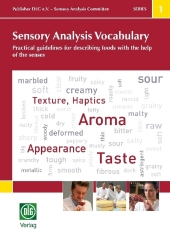 Neuerscheinungen 2017Stand: 2020-02-01 |
Schnellsuche
ISBN/Stichwort/Autor
|
Herderstraße 10
10625 Berlin
Tel.: 030 315 714 16
Fax 030 315 714 14
info@buchspektrum.de |

Deutsche Landwirtschafts-Gesel
Sensory Analysis Vocabulary
Practical guidelines for describing foods with the help of the senses
Herausgegeben von Deutsche Landwirtschafts-Gesellschaft (DLG)
2017. 232 p. w. numerous col. figs. 30.3 cm
Verlag/Jahr: DLG 2017
ISBN: 3-7690-0846-4 (3769008464)
Neue ISBN: 978-3-7690-0846-3 (9783769008463)
Preis und Lieferzeit: Bitte klicken
In many enterprises in the food industry the use of human senses for testing and measuring purposes - in other words sensory analysis - is an elementary component of development, production and supervisory processes. One challenge that regularly confronts testers is how to put the sensory impressions perceived into words in order to describe the food quality. Up to now, a defined specialist sensory vocabulary has only existed sporadically in some sub-sectors of sensory analysis. Translating the sensory impressions into language has thus so far generally been left to each assessor individually, which frequently leads to misunderstandings in communications between practitioners in day-to-day operations.
The publication "Sensory Analysis Vocabulary" is an introduction to the complex issue of unifying the language of sensory perceptions. Alongside the fundamentals of sensory (language) response to foods, it contains a cross-product basic vocabulary and ten product-group-specific specialist vocabularies. The vocabularies contain descriptive terms with definitions and reference examples and are structured in accordance with the sensory test characteristics Appearance, Texture/Haptics, Odour/Aroma and Taste/Basic Taste. They are also ideal for panel training sessions.
This reading material and code of practice drawn up by representatives of the industry for the industry gives sensory analysis practitioners from the fields of quality assurance, product development and marketing, from academia and education, the food industry, research institutes and commercial laboratories, as well as from official controls of foodstuffs a practical tool, a reference work and a training instrument that facilitates operational practice.


